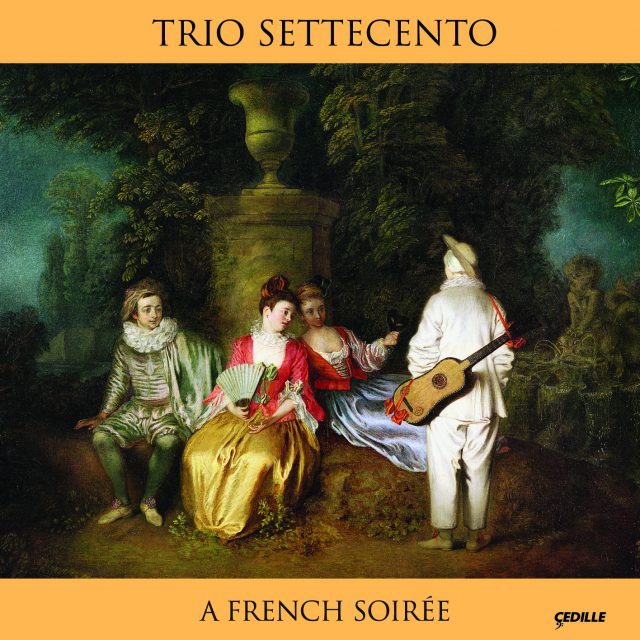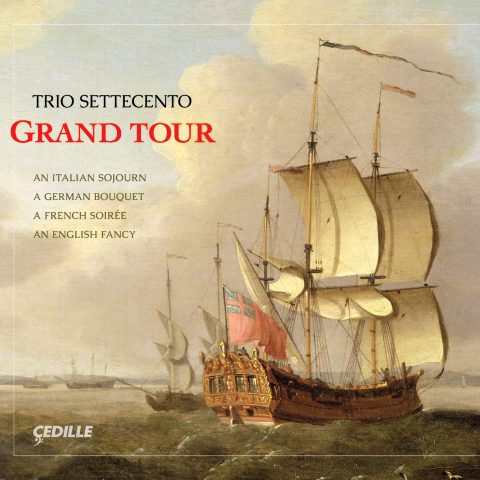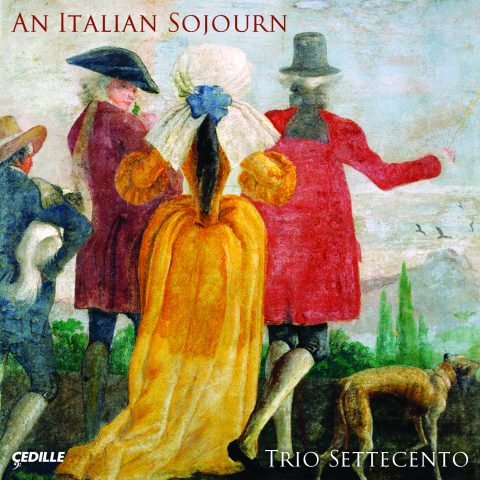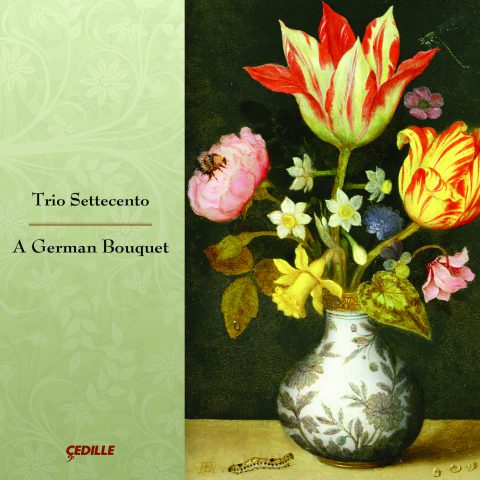Store

A French Soirée is the newest installment in Trio Settecento’s acclaimed, country-by-country grand tour of the European Baroque on Cedille Records. The new CD is a companion to the period-instrument ensemble’s An Italian Sojourn and A German Bouquet.
Performing on antique instruments of rare beauty and expressive power, this trio of virtuosos breathes life into musical masterpieces that capture the poetic gestures of the French school.
On A French Soirée, Trio Settecento brings its imagination, vigor, technical polish, and historical insight to a program that illuminates divergent cultural sensibilities of Baroque France. Some works illustrate the regal, socially conservative, and authoritarian aesthetic of the court of Louis XIV. Others, which would have been heard in the salons of disaffected nobles and wealthy merchants, reflect a more free-spirited, cosmopolitan, and humanistic outlook.
Preview Excerpts
JEAN-BAPTISTE LULLY (1632–1687)
from Ballet Royal de Flore
FRANÇOIS COUPERIN (1668–1733)
MARIN MARAIS (1656–1728)
FRANÇOIS COUPERIN
MARIN MARAIS
FRANÇOIS COUPERIN
Troisième Concert
JEAN-FÉRY REBEL (1666–1747)
Sonate Huitième en Ré mineur
JEAN-PHILIPPE RAMEAU (1683–1764)
Quatrième Concert
JEAN-MARIE LECLAIR (1697–1764)
Sonata en Sol majeur
Artists
Program Notes
Download Album BookletA French Soiree
Notes by John Mark Rozendaal
The lush blossoming of artistic activity that coincided with the reigns of the Bourbon kings of France is well known. To satisfy the demands of the most ostentatious royal court ever seen in Europe and other competitive consumers of luxury — aristocrats and wealthy Parisians — fine artists, artisans, performing artists, and men of letters produced a flood of objects and occasions whose sumptuousness immediately became legendary, and whose remnants continue to astound. At the same time, the centralization of power and wealth that Louis XIV and his ministers promoted in France had the effect of instituting an absolute cultural hegemony whereby all of the arts were compelled to respond (affirmatively or otherwise) to the ethos of the royal court — and later to that of Paris and its “counter-court” (musicologist Georgia Cowart’s term) of alienated nobles and wealthy bourgeois. Every piece on this disc was originally published in a print bearing the Royal Privilége; and each can be located on a sort of continuum of polar covalence between the values of the Sun King (even after his death) and those of an opposing coalition including a colorful array of nobility, libertins, artists, and free spirits.
Characteristics of Louis XIV’s reign and ideals as expressed in his cultural program included: military glory (represented in music by trumpets and drums), social conformity and submission to hierarchical authority (musically embodied by the uniform execution of the Vingt-quatre violins du Roi), nationalism, masculinity, heterosexuality, and, in later years, prudish piety. Opposing values would be: peace and love (musically associated with oboes and musettes), individualism (flamboyant instrumental virtuosity), foreignness (especially Italianism in music), femininity, homosexuality, and, in later years, comic theater. (Peace and love continue to resonate as counter-cultural values, at least as recently as the American culture wars of the 1960s and 1970s when the slogan, “Make love, not war” was widely regarded as both disloyal and licentious.)
The Divertissement that opens our program presents works by three of the greatest musicians who worked for Louis XIV in a suite like those heard at the sort of soirée François Couperin describes as a regular feature of the king’s routine in his latter years. In the preface to his Concerts Royaux, Couperin writes:
The following pieces are of a different sort from those which I have offered up to the present. . . . I composed them for the little chamber concerts which Louis the Fourteenth made me attend nearly every Sunday of the year. . . . I have arranged them by keys and kept the same titles by which they were known at court in 1714 and 1715.
We imagine that these occasions might have included music by composers other than Couperin. Hence our suite includes works by Jean-Baptiste Lully, long dead but well remembered in 1714, and the beloved bass de viole virtuoso, Marin Marais.
The purest expression of the absolutist ideal in the performing arts came from the collaboration of the king with his friend and musical deputy, Jean-Baptiste Lully (1632–1687). Lully was a native of Florence who, within a few short years of his arrival in France, had risen to a position of prominence and leadership in the royal musical establishment. Lully created a musical theater so compelling and so perfectly aligned with the king’s tastes and ambitions that it became the definition of Frenchness in music, a standard against which all new creations were evaluated until the revolution.
However, even Lully’s personality and social sympathies were not always in alignment with the King’s. In one production after another, the themes of love and peace are so compellingly presented that they threaten to undercut the works’ nominal purpose of promoting regal glory. The Ballet Royal de Flore of 1669 was the last court ballet in which the king danced, appearing as the sun itself. The piece is a celebration of the (brief) peace brought to Europe by Louis XIV, an obviously sycophantic interpretation of the outcome of the War of Devolution. Lully’s career ended in difficulty after he was observed in a homosexual liason. Louis threatened him with prosecution and declined to finance his final operatic productions.
François Couperin (1668–1733), one of the subtlest wits in the history of music, managed, like William Byrd and Dmitri Shostakovich, to stay close to the nexus of power while lacing his music with encoded dissident features. Famously, Couperin embraced Italianism in music seeking to combine the best qualities of both French and Italian music. While enjoying the music of Les Goûts réuinis, the king may well have been unaware of the nature of this project. Although Italianate compositional tactics are integrated, Couperin’s pièces remain suffused with uniquely French tendresse, grace of melody, and emotional complexity. Their poignant nostalgia, often referencing a courtly brilliance long lost to their first hearers, forms a precise aural analogue to the wistful pleasures of Watteau’s Fêtes gallants.
Marin Marais (1656–1728), the Chopinesque poet of that quintessentially French solo vehicle, the basse de viole, is here represented by the exquisite pièce de charactère, La Guittare, and the great G Major Chaconne. The guitar was popular with aristocrats and carried a double emblematic identity. Played in the rasgueado (strummed) manner, the instrument could have a raucous, lascivious sound suggestive of its Spanish origins and association with the Italianate theater of the commedia dell’arte. Played with the punteado (plucked) technique, the guitar recalled the French lute and played the précieuse art music associated with the “feminized space” of the salon. Marais’s imitation of the guitar cleverly alternates between the two idioms to create a scenario both pleasingly varied and diplomatic.
The three chaconnes included on this program are all chamber music works offering distinct commentaries on the famous theatrical genre. The Marais chaconne appeared in the composer’s 1686 collection dedicated to his teacher and mentor, J.-B. Lully. Lully had transformed the chaconne from a lewd dance accompanied by the vigorous strumming of Spanish guitars into an opulent celebratory set piece, obligatory for marking the most joyous moments of ballets and operas. The Marais work is a sincere compliment to the elder composer, already disgraced at court, who would pass from the scene less than a year after this publication. Nearly thirty years later, François Couperin’s Chaconne leger inverts the chaconne’s usual major-minor-major key scheme in a poignant piece that recalls past grandeur in a work at once vigorous and delicate. Jean-Marie Leclair (1697–1764), composing circa 1740, apparently ignores the form’s history and exploits the chaconne’s potential to thrill in a virtuoso star turn signifying the transformation of the violin from a core element of a dance band into a vehicle for expression of personal virtù, individualized sentiment, and extraordinary capability.
Another approach to the reunion of French and Italian tastes can be heard in the Sonata in D Minor (1713) of Couperin’s near contemporary, the distinguished violinist and composer of opera and ballet, Jean-Féry Rebel (1666–1747). In this work, Rebel deftly combines diverse elements into a satisfying unity: a dramatic prelude whose craggy contours exploit the extremes of range of both violin and basse de viole, a courante deeply indebted to Arcangelo Corelli’s Opus V sonatas, and a gracious Rondeau in the gallant style so favored by French instrumentalists of the period.
The last three works on our program all date from the 1740s and breathe an entirely new spirit. One notices immediately the extraordinary demands of virtuosity made upon the performers. After the death of Louis XIV in 1715, the court moved to Paris during the regency of the Duc d’Orleans. Although the court returned to Versailles after the majority of Louis XV (1723), the musical center of the nation remained in Paris, where music was heard in the homes of the wealthy and in several important public concert series. Louis XV himself had little interest in music or ceremonial expressions of power. In this context, the plastic arts turned to domestic themes both humble and ostentatious, and always sensuous, refined, and prepared with the utmost skill and care. Here, the visual art parallels would be Jean-Baptiste-Siméon Chardin’s paintings of copper pots and groceries, and interior decors famed for luxury, comfort, and intimacy. In concerts, the public’s attention was drawn more and more to the miracles that could be wrought by the hands of a single instrumentalist, gifted and painstakingly trained to ever greater feats of digital athleticism and tonal voluptuousness. This taste happily coincided with the new reign’s tolerance of performers from Italy, the birthplace of the most advanced violinists of the era, and with the Enlightenment’s interest in human potential, including a virtù that was not the exclusive province of hereditary nobles.
Unlike the other composers represented on this program, Jean-Philippe Rameau (1683–1764) did not hold a court appointment. He spent the better part of his Parisian career composing opera and chamber music supported by the patronage of M. Le Riche de La Pouplinière. Rameau’s collection of Pièces de Clavecin en Concert (1741) is virtually sui generis. In the baroque era, keyboards participated in ensemble music by providing continuo accompaniments, the harmonic foundation against which the other instruments and voices displayed their virtuosity. In Rameau’s Pièces, elaborate keyboard parts are supported and engaged in dialogue by the violin and basse de viole who provide a vigorous repartee. La Pantomime references the practices of the Italian Commedia dell’arte, a favorite subject of Watteau even during the two decades when the Italian troupe was banished from France for having offended Louis XIV (1697–1717). L’Indiscrette is a portrait of a personality type. It should be noted that by convention the titles of these character pieces are always feminine even when referring to a man (this “indiscrete person” could possibly be male). In any case, we imagine that this movement depicts an individual transported by the joys of gossip. La Rameau appears to imitate the sounds of the composer’s busy household, including practice of repetitive exercises on the harpsichord and a barking dog.
Antoine Forqueray (1671–1745) was a prodigous virtuoso of the basse de viole whose mastery invited comparison with that of Marin Marais. Évrard Titon du Tillet famously asserted that whereas Marais played like an angel, Forqueray played like the devil. In 1682, the Mercure gallant reported that the ten-year-old Forqueray had played for the king on the basse de violon (the precursor of the violoncello). Louis was so impressed with the child’s skill on the Italianate instrument that he suggested Forqueray should be taught the basse de viole, the nobler, more characteristically French instrument.
Antoine Forqueray’s five suites were published posthumously by his son in 1747 in two versions, one for basse de viole, the other for harpsichord. Forqueray’s suites include portraits of Forqueray’s friends and colleagues including Couperin, Rameau, “La Regente” (the Duc d’Orleans: a student of Forqueray, nephew of Louis XIV, central figure in the Parisian “counter-court,” and great supporter of Italian music), and Leclair.
Jean-Marie Leclair came from a family of multi-talented people: dancers, lacemakers, and violinists. Leclair mastered all three arts himself. Leclair’s early career took him to Turin and Kassel where he studied with the Italian virtuosi Somis and Locatelli. When Locatelli and Leclair performed at Kassell, it was said that Leclair played like an angel and Locatelli played like the devil. The influence of Locatelli’s left-hand pyrotechnics is clearly heard in Leclair’s sonatas after 1728.
We are grateful to the vigorous printing industry of eighteenth-century France for making the musical heritage of its culture so widely accessible then and now. The original prints of this repertoire are so beautifully and carefully prepared that we are easily able to perform from facsimiles of first editions. Indeed, the Lully pieces from 1669 were the only items on this disc for which we needed to consult a modern edition.
John Mark Rozendaal and Trio Settecento wish to thank Mary Anne Ballard for the generous loan for this recording of the beautiful basse de viole made in 1743 by Jean Ouvrard.
Album Details
Total Time: 78:55
Producer: James Ginsburg
Editing: Jeanne Velonis
Engineer: Bill Maylone
Technical Editing: Bill Maylone
Front Cover Design: Adam Fleishman
Inside Booklet & Inlay Card: Nancy Bieschke
Cover Painting: The Foursome, c.1713 (oil on canvas) by Jean Antoine Watteau (1684-1721); Fine Arts Museums of San Francisco, CA / The Bridgeman Art Library
Recorded: August 10-14, 2010, in Nichols Concert Hall at the Music Institute of Chicago, Evanston, Illinois
©2011 Cedille Records/Cedille Chicago
CDR 90000 129



